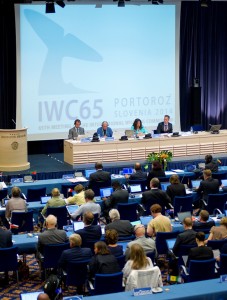Campaigning at the International Whaling Commission (IWC) to protect whales, dolphins and porpoises
We have unwaveringly campaigned at the International Whaling Commission (IWC) to maintain and strengthen the international commercial whaling ban, commonly known as the moratorium, that provides vital protection for the great whales.
With a combination of credible scientific research, multiple reports and advocacy over 35 years, we have continued to highlight the increasing human threats to whales, dolphins and porpoises in addition to hunting and have been a key force in expanding the IWC’s work to address them.
EIA co-founder Allan Thornton was already involved in the battle to save cetaceans before EIA was formed. He set up Greenpeace UK, bought the Rainbow Warrior and masterminded its campaign against Icelandic whaling.
In the early 1980s, Allan began attending IWC annual meetings, working with other NGOs and governments to persuade the IWC to agree an international ban on commercial whaling.
Spotlighting ‘forgotten’ small cetaceans
Once the moratorium was implemented in 1986, EIA began to draw the IWC’s attention to the plight of the ‘forgotten’ smaller whales, dolphins and porpoises often referred to as small cetaceans.
In 1986, EIA began submitting papers on the Faroe Islands’ pilot whale hunt to the IWC, resulting in the adoption of three IWC resolutions pressuring the Faroese Government to address the inherent cruelty and dramatic increase in the number of whales killed. This resulted in improvements to killing methods and reductions in numbers killed.
In 1990, EIA published the Global War Against Small Cetaceans, the first of three reports exposing the annual slaughter of hundreds of thousands of small cetaceans around the world, calling on the IWC to act.
Tackling the Dall’s porpoise hunt
We worked with the UK Government to propose a resolution in 1990 on the Dall’s porpoise hunt, which had increased from about 10,000 a year to more than 40,000 after the moratorium was implemented. This was the first small cetacean resolution ever adopted by the IWC and the start of a new era..Japan initially promised to abide by the Resolution and the catch reduced from more than 40,000 to 11,000 in 1992.
 Pushing environmental concerns up the agenda
Pushing environmental concerns up the agenda
In the early 1990s, only five years after the moratorium was implemented, some scientists claimed slow-breeding whales were beginning to recover and the ban may not be justified. At the same time, the ozone hole and climate change were becoming widely recognised as serious global threats, the impacts of ocean pollution were being noted and untold numbers of cetaceans were dying in fishing nets.
EIA argued long and hard that a sustainable catch limit could not be calculated unless the impact of environmental threats on whale populations was clearly understood. This resulted in environmental concerns becoming a standing item on the IWC’s Scientific Committee agenda and, subsequently, at annual meetings. This work, initially dismissed by some as an insignificant ‘side line’, is now the primary focus of much of the IWC’s work.
Although opinions over commercial whaling are divided, most IWC member recognises that all cetaceans face significant threats from overfishing, climate change, chemical and plastic pollution and other man-made impacts on the oceans and that the IWC has an important role in mitigating these threats.
Looking ahead 50 years
The next 50 years will be critical for the future of the planet but represent just two generations for the largest whales. As the IWC approached its 75th anniversary in 2021, its 68th meeting in 2022 provided the perfect opportunity to define a clear 50-year vision that goes beyond managing whaling and establish the IWC at the centre of global efforts to conserve all cetaceans and enable them to meet their full ecological potential as engineers of a healthy marine environment.
As part of a coalition of NGOs, EIA contributed to the production of a 50-year vision for the IWC.
The issue of plastic pollution within the IWC is key to developing our 50-year vision which establishes the IWC at the centre of global efforts to conserve all cetaceans.
EIA reports and advocacy to the IWC
Over the years, EIA has produced many reports which have aimed to influence the IWC’s important work to protect whales, dolphins and porpoises. They include:
- Oceans under siege: environmental threats to whales, dolphins and porpoises (2005)
- Renegade Whaling: Iceland’s Creation of an Endangered Species Trade (2011)
- Illegal drift netting in the Mediterranean (2014)
- Plight of the Ocean Sentinels (2016)
- Commercial Whaling: Unsustainable, inhumane, unnecessary (2018)
- A Sanctuary for Whales: Protecting marine biodiversity through the International Whaling Commission (2018)


